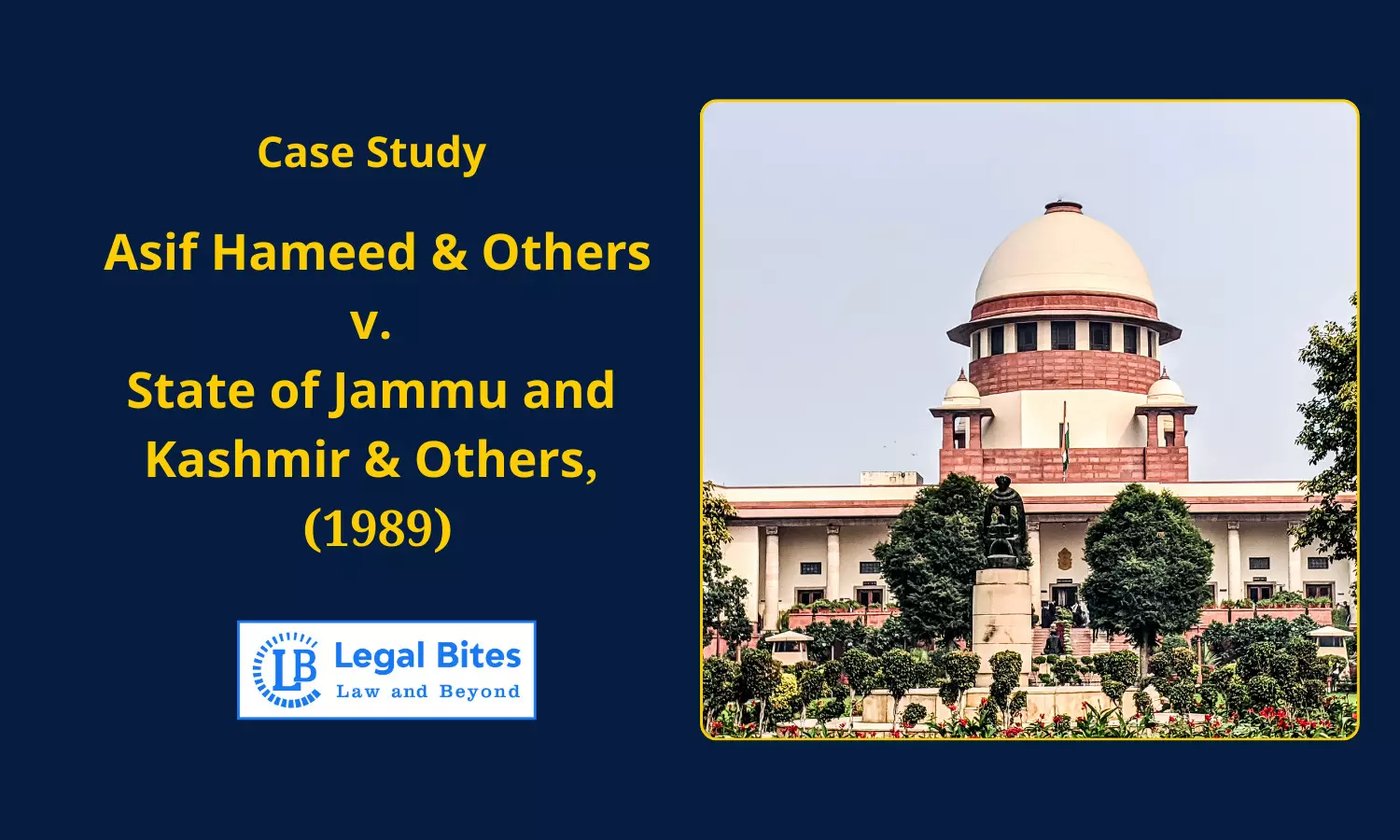Case Study: Asif Hameed & Others v. State of Jammu and Kashmir & Others, (1989) | Separation of Powers
This case stands as a significant milestone in elucidating the boundaries of executive authority as outlined in Article 162.

This case stands as a significant milestone in elucidating the boundaries of executive authority as outlined in Article 162. The 'Case Study: Asif Hameed & Others v. State of Jammu and Kashmir & Others' is a case on the doctrine of separation of powers wherein the extent of the executive power of the State as enshrined under Article 162 of the Indian Constitution has been thoroughly deliberated upon along with Article 246.Case Title: Asif Hameed & Others v. State of Jammu...
This case stands as a significant milestone in elucidating the boundaries of executive authority as outlined in Article 162. The 'Case Study: Asif Hameed & Others v. State of Jammu and Kashmir & Others' is a case on the doctrine of separation of powers wherein the extent of the executive power of the State as enshrined under Article 162 of the Indian Constitution has been thoroughly deliberated upon along with Article 246.
Case Title: Asif Hameed & Others v. State of Jammu and Kashmir & Others
Court: Supreme Court of India
Citation: AIR 1989 SC 1899
Judges: Justice K.N. Singh, Justice K. Jagannatha Shetty and Justice Kuldip Singh
Date of Judgment: May 3rd, 1989
Facts
- In 1988, a large number of candidates who were unsuccessful in gaining admission to medical and dental courses in government colleges in Jammu & Kashmir (hereinafter as “J&K”), for the session of 1988-89, filed writ petitions in the High Court.
- They argued that the selection process conducted by a 'competent authority' appointed by the state government was not valid.
- The High Court had directed in an earlier 1987 case, namely, Jyotshana Sharma v. State of J&K (decided on April 17, 1987), that the selection process should be conducted by an independent statutory body instead of an authority constituted by the government. In this case, the selection for the session 1986-87 was challenged.
- The unsuccessful candidates contended that by not adhering to the 1987 directive, the state government violated the High Court’s order as the “competent authority” was to be constituted by the government as per the order issued by the state government on May 18, 1987, which was in direct violation of what the High Court had directed.
- The selection process designed by the competent authority involved an objective entrance exam and viva voce interview. The candidates were evaluated on predefined parameters.
- The High Court ruled in favour of the unsuccessful candidates and held the selection process invalid for not complying with its earlier directive.
- The appointment of the competent authority on May 19, 1987 was also challenged regarding which the High Court directed the state to reconstitute it which was done so by the State.
- The state government, successful candidates and some unsuccessful candidates have filed appeals in the Supreme Court against the judgment of the High Court. The selection process implemented by the reconstituted competent authority was also challenged.
Issues
- Whether the High Court exceeded its constitutional authority by directing the state government to constitute an independent statutory body for selections.
- Whether the doctrine of separation of powers was violated by the High Court issuing directives to the executive branch.
- Whether the selections conducted by the competent authority violated the directives of the High Court and should be invalidated on that basis.
- Whether the selection process designed and implemented by the competent authority was reasonable and constitutionally valid.
Laws Applied
- Article 162 of the Constitution of India, 1950
- Article 246 of the Constitution of India, 1950
Arguments Before Court
- The appellants argued that the selection process violated the binding directives issued by the High Court in its previous 1987 judgment. The High Court had directed the state government to entrust the selection process to an independent statutory body, however, the state constituted the competent authority to conduct selections. This violated the order of the High Court.
- They also contended that the competent authority was under executive influence and not independent. They pointed out deficiencies and also alleged the actual scrutiny was done by a separate government committee rather than the competent authority.
- Further, there were discrepancies in the selection criteria and process followed by the competent authority in the entrance exam and viva voce test.
- The state government argued that the High Court’s observations in the previous 1987 judgment were mere suggestions, not binding directions. Even if considered directions, they submitted they had adequately complied with them by constituting the competent authority.
- They contended the competent authority was validly set up through executive powers as per the Constitution. They asserted the selection process designed and followed by the competent authority was reasonable and constitutionally valid.
- It was additionally argued that no specific discrepancies were found in the actual selection process and the scrutiny done by the competent authority. It was maintained the High Court cannot direct the legislature to enact a law to constitute a statutory body.
Judgment
The court has deliberated upon the doctrine of separation of powers as noted that the three organs, namely, the legislature, the executive and the judiciary must function within their spheres and not perform the functions of the other. While this doctrine is not strictly followed in India, the Constitution has differentiated the specific functions of each.
The court further stated that judicial review could keep a check on any unconstitutional exercise of power by the other branches, but the only restraint on the judiciary is “self-imposed discipline”.
When a state action is challenged in court, the judiciary must examine if the legislature or executive has acted within their constitutional powers. If not, the court can strike down the action, while remaining within limits on the power of judicial review. The court cannot advise or direct executive policy matters within the executive’s authority, as long as constitutional boundaries are not crossed.
The court noted that the direction of the High Court to establish a “statutory independent body” meant that the state legislature was required to formulate a law concerning that. However, by the provisions laid down by the Constitution, courts cannot issue directions to the legislature to formulate laws as it is a subject matter strictly meant for the legislature to consider.
Therefore, the Court held that the High Court transgressed its constitutional authority by issuing directions to the state government regarding the selection process in the 1987 case. The executive branch has the exclusive constitutional power to formulate policies and procedures for medical college admissions in the state. Therefore, the High Court cannot issue directions to the legislature regarding the formulation of legislation as that would violate the doctrine of separation of powers.
In the case of Farooq Ahmed Bacha v. State of J&K, (CR - 87/2012), wherein the selection for the year 1987-88 was challenged, the Court had repeated the need to have an independent statutory body. The instant court agreed with the High Court’s observation that the directions of the High Court in the 1987 case were mere suggestions.
Regarding the question of the reconstitution of the competent authority, the apex court in the instant matter held that the state government had substantially complied with the directions of the High Court by establishing the competent authority through executive orders. Therefore, it rejected the arguments relating to the deficiencies in the composition of the competent authority and functioning.
The Court found the selection process designed by the competent authority involving an objective entrance exam and viva voce test was reasonable and constitutionally valid. It held no specific discrepancies in the actual entrance test, viva voce or selection results. The Court noted it would favour a selection method that eliminates human discretion and bias, even if it brings in a small element of chance.
Such an objective entrance exam and viva voce test was also considered in the case of Koushal Kr. Gupta v. State of J&K, (1984) 2 SCC 652, wherein it was observed that the viva voce test must be conducted in a reasonable and just manner without arbitrariness or bias and that such a viva voce is considered to be valid. Similarly, in Atul Khullar v. State of J&K, 1986 Supp SCC 225, the objective entrance and viva voce selection process for the selection session 1984-85 was approved by the apex court. These precedents supported upholding the current selection method designed to minimize subjectivity through predefined parameters and the Court preferred this over discretionary selection which is prone to bias and favouritism.
The Supreme Court ruled that the mere non-participation of one member does not by itself invalidate the competent authority’s selections. It stated that without statutory provisions, the authority could legitimately function with two members. The court also held that the expert committee appointed had only assisted the competent authority, which had scrutinized and approved the selection results.
In conclusion, the instant court allowed the appeals of the state government and the successful candidates and dismissed the appeals of the unsuccessful candidates. It also set aside the judgment of the High Court. The selection process and the results were upheld because the competent authority was validly constituted under the executive powers and had followed a fair and reasonable procedure for selections.

Dewanshi Agarwal
Dewanshi possesses a solid understanding of legal principles and demonstrates remarkable effectiveness in articulating them through her writing skills. Institution: National University of Study and Research in Law, Ranchi
